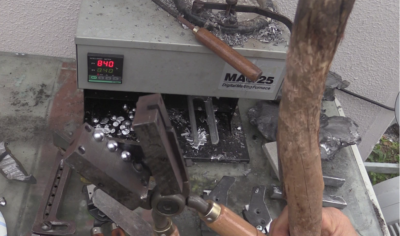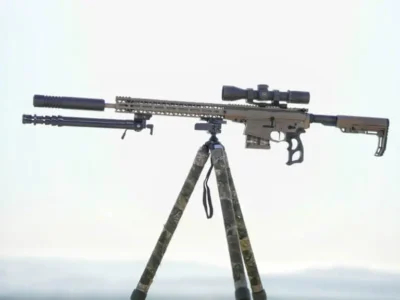Metallurgy isn’t a fuzzy science. When it comes to mixing metals, certain rules give you guaranteed certain results. But when it comes to casting bullets, the metalurgy isn’t as simple as you might expect. Small variances in temperature or handling can affect your bullets a great deal. But to a certain degree, you can count on a usable product with a given set of set variables, and that has been our focus here. For this article we decided to take a look at the mechanics of common casting alloys. You can buy completed alloys for just over $2-$3 per pound, but if you can find a free source for the main component of cast bullets, the lead, you can bring your cost down substantially. With the additions of small amounts of additional metals, your bullets can be made harder than pure lead, and this makes them able to handle more pressure and velocity. With virtually no sacrifice in performance, you can shoot just about any handgun caliber, and even some rifle calibers, using cast bullets, at a fraction of the cost of jacket rounds.
Search: casting bullets
Show First
Casting Balls and Bullets for Black Powder Pistols
Bullet casting is not a complicated process. And it can provide you with almost free bullets for life. At some point you have to admit to yourself that we may not ever return to “normal,” and that is about where I am right now. So if you want to be able to shoot at a [...]
Free Bullets for Life – Bullet Casting 101 Part 1
If you love to shoot it can get expensive. Factory ammo is not at its peak that it was during 2009 into 2010, but even cheap 9mm is still upwards of 30 cents per round. If you reload, you save the cost of the brass, and the savings are huge over factory loads, but you still have to buy the bullets. And while bullets have improved drastically over the last ten years in consistency and quality control, with these improvements have come higher prices. Spot metals on the commodity market have spiked as well, sending prices even higher. Bullets aren’t cheap anymore. You may pay almost as much for the box of bullets as you used to pay for the box of loaded ammo.
I started bullet casting about 15 years ago, and initially I treated it like some sort of black art, that only the gurus could get right. Back then you could get lead for next to nothing. Pipes were still being torn out of old houses that were made of lead, and every junkyard and tire shop had a good supply of used wheel weights, the kind with the steel clip. I tried my best to make perfect bullets with no lines in them, that all weighed the same, and I had some moderate success. But I can’t say I ever mastered that, and if I ever get back into being able to shoot BPCR (black powder cartridge rifle), maybe I’ll try again.
Recently it occurred to me that I don’t hear as much about bullet casting as I should these days. Did everyone forget about it? Jacketed bullets are too darned expensive to shoot all the time, but I like to shoot all the time, and I’m not alone. Once you start asking around, stopping in at tire places and developing a hawk eye for lead at the junkyard and flea market, you can usually get lead for free or extremely cheap. Once you buy the tools, you have them for life and they last. If you learn the basic skills of bullet casting, it could amount to a lifetime of free bullets.
Casting a Smaller Shadow, New CZ Shadow 2 Compact Packs A Punch
In virtually every other way, the Shadow 2 Compact is identical to its big brother. Of course, that doesn’t mean much to you if you are not familiar with the original Shadow 2. Not to worry, that’s what this review is for!
Bullet Casting for Beginners Part 2 – Hardness, Sizing & Lubing
Once you understand the basics of bullet casting, which we covered in Part One of this series, you are well on your way to a finished bullet you can actually shoot. The next two steps are sizing and lubing the bullet, which we will cover here. I will also go over the basics of “hardness,” which will determine how much pressure and velocity your finished bullet can handle. If you are already a handloader/re-loader, you should be able to load up your bullets after this installment. This is not rocket science as you will soon see, and a lot of the mythology of bullet casting you can pretty much ignore for simple range rounds. Remember we started this series with the concept of “free bullets for life.” The more you complicate anything the more expensive it becomes, so at first, let’s just keep it simple.
Slowing Down with a Traditions Kentucky Rifle
This 50-caliber muzzleloader is often the first choice for those looking to get into traditional black powder. Let’s get back to the basics as I spend some time with the Traditions Kentucky Rifle.
How To Make Flat Springs
If you restore or repair older firearms, you will eventually run into a broken spring for which a replacement is unavailable. Being able to make a replacement is a very useful skill to have.
Lightweight Wonder: Weatherby Model 307 Alpine MDT Carbon Reviewed
With carbon fiber everything, a folding stock chassis, modern and effective muzzle brake design, updated action, and feather-light weight, why would you build a custom hunting rifle when you can buy this factory rifle that already has everything you want?
10 Second Muzzleloader Reload! – Answer to “The Second Shot”
Estimated reading time: 11 minutes I intend to get the bullet into the barrel within 10 seconds, for heaven’s sake! Not the whole process of reloading. And honestly on the video, it took me 15. But compare that to a plastic dump tube muzzleloader reload kit that you would buy at Walmart or Cabela’s. This [...]
Building the Ultimate Ultralight, Long Range, Semi-Auto
The goal of this rifle build for me was to build an ultra-light semi-auto long-range rifle that was capable of multiple precision shots out to 1000 yards and weighed less than 7 lbs








